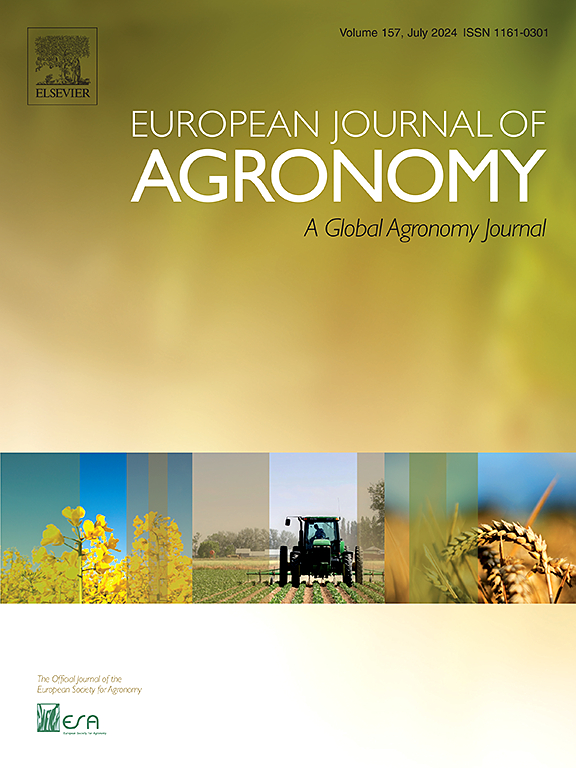在产量差距小的情况下确保可持续作物生产:印度西北部小麦农场的数据驱动综合评估
IF 4.5
1区 农林科学
Q1 AGRONOMY
引用次数: 0
摘要
在过去的几十年里,印度西北部的小麦产量显著提高。然而,这伴随着投入水平的提高和集约化生产实践,对当前种植制度的经济和环境可持续性提出了质疑。该地区的小麦农场需要进行多标准综合评估,以了解未来清洁小麦生产的范围。对灌溉麦田(n = 3928)的生产实践进行了多重可持续性指标评价,即产量缺口、氮肥利用效率、盈利能力和温室气体排放。采用随机前沿分析与模拟潜在产量数据相结合的方法,确定了该地区小麦产量缺口的成因。通过计算氮的部分要素生产率来估计氮的利用效率,根据报告的投入产出数量和价格计算盈利能力,并使用减缓选择工具(MOT)对温室气体排放进行量化。这些指标在不同情况下(即不同指标的不同权重),使用与理想解决方案相似的偏好排序技术(TOPSIS)进行多标准评估。对于每种情况,农民的田地被分类为最有效、最有效、最低效和最低效,随机森林被用来确定最重要的管理实践来控制田地的分类。小麦产量差距较小(25-30 % Yp或2.4 t ha−1),主要归因于技术产量差距(约20 % Yp或1.5 t ha−1)。对所有指标权重相等的情景中农民的农田进行排名和分组,结果显示,在生产力水平为 4.5 t ha - 1的情况下,至少有25% %的农田温室气体排放量非常高(>1500 kg CO2-eq ha - 1),而且在印度西北部,最高效农田的表现表明,在不影响产量的情况下可持续生产小麦是可能的。对于效率最低的农田,可以调整耕作强度和施氮量(10% %效率最低的农田采用零耕作,80% %效率最高的农田采用零耕作),以实现更高产量、更低温室气体排放、更高利润和更高氮利用效率的总体目标,而残茬保留和耕作强度则需要优先考虑,以最大限度地减少温室气体排放。对于效率最高的农田,温室气体排放量的减少总是与产量水平的下降有关。田间分类最重要的管理实践包括前一种水稻作物的种植方法、耕作作业次数、残茬保留和小麦的氮肥用量。该研究提供了一种数据驱动的方法来筛选绩效指标之间的权衡,并确定能够在未来实现可持续和更清洁的作物生产的管理实践。本文章由计算机程序翻译,如有差异,请以英文原文为准。
Ensuring sustainable crop production when yield gaps are small: A data-driven integrated assessment for wheat farms in Northwest India
Northwest India achieved remarkable wheat productivity gains during the past decades. However, this has been accompanied by increasing input levels and intensive production practices, raising questions about the economic and environmental sustainability of current cropping systems. A multicriteria integrated assessment is required for wheat farms in the region to understand the scope for cleaner wheat production in the future. Production practices from irrigated wheat fields (n = 3928) were evaluated for multiple sustainability indicators, namely yield gap, nitrogen (N)-use efficiency, profitability, and greenhouse gas emissions. Stochastic frontier analysis was combined with simulated potential yield (Yp) data to identify the causes of wheat yield gaps in the region. N-use efficiency was estimated by calculating the partial factor productivity of N, profitability was computed based on reported input-output amounts and prices, and greenhouse gas emissions were quantified using the Mitigation Options Tool (MOT). These indicators were subjected to a multicriteria assessment using the Technique for Order of Preference by Similarity to Ideal Solution (TOPSIS) under different scenarios (i.e., different weights for different indicators). For each scenario, farmers’ fields were classified as most efficient, efficient, less efficient, and least efficient, and random forest was used to identify the most important management practices governing the field classification. Wheat yield gaps were small (25–30 % of Yp or 2.4 t ha−1) and mostly attributed to the technology yield gap (ca. 20 % of Yp or 1.5 t ha−1). Ranking and grouping the farmers’ fields in the scenario with equal weights for all indicators revealed that at least 25 % of the fields had very high greenhouse gas emissions (>1500 kg CO2-eq ha−1) at a productivity level of < 4.5 t ha−1, and that it is possible to produce wheat sustainably without compromising yields in Northwest India, as indicated by the performance of the most efficient fields. Tillage intensity and N application rates can be adjusted for least efficient fields (<10 % least efficient fields adopting zero tillage vs >80 % most efficient fields adopting zero tillage) to achieve an overall objective of higher yield, lower greenhouse gas emissions, more profit and higher N-use efficiency, whereas residue retention and tillage intensity would need to be prioritized for minimizing greenhouse gas emissions. For the most efficient fields the decrease in greenhouse gas emissions was always associated with a decline in yield level. The most important management practices governing the field classification included the crop establishment method used for the previous rice crop, the number of tillage operations, residue retention, and the N fertilizer rate for wheat. The study provides a data-driven approach to screen trade-offs between performance indicators and to identify the management practices that can deliver sustainable and cleaner crop production in the future.
求助全文
通过发布文献求助,成功后即可免费获取论文全文。
去求助
来源期刊

European Journal of Agronomy
农林科学-农艺学
CiteScore
8.30
自引率
7.70%
发文量
187
审稿时长
4.5 months
期刊介绍:
The European Journal of Agronomy, the official journal of the European Society for Agronomy, publishes original research papers reporting experimental and theoretical contributions to field-based agronomy and crop science. The journal will consider research at the field level for agricultural, horticultural and tree crops, that uses comprehensive and explanatory approaches. The EJA covers the following topics:
crop physiology
crop production and management including irrigation, fertilization and soil management
agroclimatology and modelling
plant-soil relationships
crop quality and post-harvest physiology
farming and cropping systems
agroecosystems and the environment
crop-weed interactions and management
organic farming
horticultural crops
papers from the European Society for Agronomy bi-annual meetings
In determining the suitability of submitted articles for publication, particular scrutiny is placed on the degree of novelty and significance of the research and the extent to which it adds to existing knowledge in agronomy.
 求助内容:
求助内容: 应助结果提醒方式:
应助结果提醒方式:


